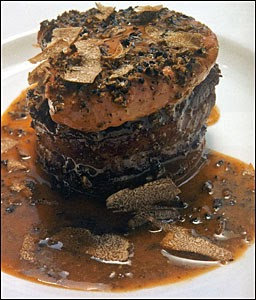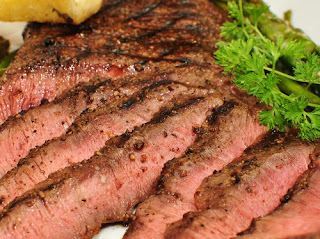from
Behind the French Menu
by
Bryan G. Newman
behindthefrenchmenu@gmail.com
A steak, as I like it, is rare-to-medium-rare.
In France, rare-to-medium-rare is à
point.
Photograph courtesy of Ernesto Andrade
www.flickr.com/photos/dongkwan/2963811001/
Ordering a steak in France cooked the way
you like it.
Ordering a steak in France requires
little French. It does not matter
whether you order a steak in English or perfect or poorly accented French. Every French server understands an order for
a steak; problems only appear when the server asks: “Quelle cuisson, votre steak?” How would you like your steak cooked? North American and UK steakhouse terms such
as medium-rare, medium, or well-done do not translate, conceptually, into traditional restaurant French.
Slices from a roast.
The terms used for a steak are the same
for slices from roasts.
Photograph
courtesy of Steve Johnson
https://www.flickr.com/photos/artbystevejohnson/4667971258/
Print out or photograph the lexicon below
from Bleu to Très
Bien Cuit
and take it with you. From Steak Frites to a Chateaubriand
or slices from a roast, just use the lexicon below to have your beef cooked the way you like it.
For a more in-depth explanation of the French
terms for how a steak should be served, read the expanded list below the
lexicon.
A lexicon for ordering your steak in
France
Bleu
– (Pronounced ble). This is an
extraordinarily rare steak, singed outside and bloody inside.
Saignant
– (Pronounced say-nyon, do not pronounce the T). The French term for a rare steak.
À
Point - (Pronounced ah pwa). Perfectly cooked. À point is used in the French kitchen
for any food perfectly cooked, not just steaks! Forget what the guidebook
says. For a steak, à point is not
only used for rare-to-medium-rare steaks! À Point is used for all dishes that are perfectly cooked. A steak in France
cooked “ à point,” will be
rare-to-medium-rare, with the accent on the rare. Rare-to-medium-rare is how the majority of
Frenchmen and women prefer their steak and that is "à point",
perfectly cooked.
Steak à point.
Photograph courtesy of abnehmen.net
www.flickr.com/photos/40489931@N06/4035041028/
Entre
à Point et Bien Cuit –
(Pronounced entray a pwan ay bien kwee). Medium rare, just a
little closer to medium. This term is not traditional restaurant French, but I
have used it many times and taught friends to use it; it will work well when
you wish to order a USA or UK medium-rare steak in France. The French word moyen, as your travel dictionary will
show, may be used for medium, but the word has no place in the French kitchen
except when possibly used to describe a medium flame. Use Entre à Point et
Bien Cuit, (entray a pwan ay bien kwee), for medium rare,
almost medium.
Bien
Cuit – (Pronounced bien kwee). Well done. In
France Bien Cuit is a medium to well-done steak, though it will still be
pink inside.
Très
Bien Cuit –(Pronounced tray bien kwee). An
exceptionally well-done steak; however, “très bien cuit” is not in any
French chef’s dictionary, though it will be clearly understood. Nevertheless, do not order France's popular steak
frites very well-done as that will bring you fried or grilled leather.
End
of Lexicon.
Tournedos Rossini.
Photograph courtesy of
MonkeyBusiness/YayMicro.com
The correct pronunciation
If
you have a few minutes to combine reading with trying one of the pronunciation
programs below. They are better than my written suggestions.
http://forvo.com/languages/fr/
(Best for single words)
https://www.howtopronounce.com/French/
(Best for phrases).
How to order a steak in France; explained
in detail.
The paragraphs below, explain in detail,
the French required when ordering a steak done to the level you prefer.
Choosing the level or degree of doneness
affects the taste and texture of your steak, so you will want to have the steak
cooked in the manner you prefer. The
shorter lexicon at the beginning of this post is all you need when traveling in
France and ordering a steak. Despite
that, this more in-depth view will give you the upper hand when ordering.
Bleu
– (Pronounced blew). French
for the color blue and the name used to order a seriously rare steak. When you feel the need for a thick and almost
raw steak, then a steak bleu will fill that need. A steak bleu indicates that the chef
will have allowed the steak to take a quick peek at the grill or frying pan in
passing on its way to your plate. A steak
bleu is just sealed on the outside; when cut, that steak will leak
copiously onto your plate; it will have been cooked, maybe, for one to two
minutes on each side.
Saignant
– (Pronounced say-nyon).The
French term for a rare steak. The direct
translation into English of the word saignant would be bloody, or bleeding; despite
that, a steak saignant
will
have been cooked a little more than a steak bleu. A steak saignant will also leak when you cut into it, though a little less copiously than a steak bleu. In North America and the UK,
a steak saignant
will still be considered a very rare steak. If you want a properly prepared but
uncooked steak, (chopped), then consider a Steak
Tartar or a Beef
Carpaccio.
À
point -
(Pronounced ah pwa). Perfectly cooked, just ready, or just
right. À point is the term used in France for all perfectly cooked foods, and not just for steaks. Unfortunately, many guidebooks give the term
“à point” as the way to order a medium-rare steak. However, a “steak à point” just means a perfectly cooked steak, and most French men and women prefer their steaks rare-to-medium-rare steak, closer to rare than medium. Consequently, the French order their steaks à point.
I have learned to prefer my steaks cooked à
point, but that was my choice over thirty years ago. French
servers with experience with English-speaking tourists will agree, generally
with a smile, to take your à point steak back into the kitchen for a few
more minutes on the grill or in the frying pan when the diner considers à point
too rare for their tastes.
Steak à point.
Photograph courtesy of stu_spivack
www.flickr.com/photos/stuart_spivack/4496410936/
When English-speaking diners in France wish to order their steaks medium-rare, I suggest they order steaks cooked “entre à point et bien cuit,” which translates as “between well cooked and à point.” The result will be a US or UK medium-rare steak, closer to medium than rare. So, for medium-rare steaks, just ask for your steak “entre à point et bien
cuit.”(Pronounced entray a pwan ay bien kwee).
Entre
à Point et Bien Cuit
– (Pronounced entray a pwan ay bien kwee). Ordering medium-rare steaks in France using "entre à point et bien cuit" has worked well for me, and all French servers will understand it. A French diner sitting near you, and observing you order a steak cooked entre à point et bien cuit
may consider your steak as overcooked; however, you are paying the piper.
Entre à point et bien cuit
Close to medium
Photograph courtesy of Jim Hammer
www.flickr.com/photos/hammer51012/26462211125/
Moyen –
(Pronounced moyen).
TO BEGIN, DO NOT USE THE WORD MOYEN WHEN ORDERING A STEAK IN FRANCE. Moyen does mean average or the middle;
however, in the French kitchen, the word Moyen has nothing to do with steaks. Moyen is
the French for average and middle, and so in some instances, it can mean
medium. Moyen is also used in expressions like
the Moyen Âge,
the Middle Ages, and Moyen-Orient,
the Middle East. In the kitchen, a chef may require a feu moyen, a medium flame, but I
have never heard moyen used by any French chef for any steak.
Then I have seen the word moyen in some guidebooks given as the
French for a medium cooked steak; it is not. It may be French-Canadian; I do
not know, but I do know that it is not French-French. Outside of well-traveled
tourist zones, it may be considered nonsense. Despite that caveat, French servers in areas frequented by tourists will generally understand when an English speaker requests a steak moyen; you will not have been the first. However, in France, a US or UK
medium cooked steak is often closer to a French steak ordered bien cuit.
Bien
Cuit – (Pronounced bien kwee). Bien cuit translates into English as well-cooked (well done); however, ordering a steak bien cuit in France generally produces a medium-to-well-done steak. A steak bien cuit will not leak; however,
its center will still be slightly rosé, pink.
A steak cooked bien cuit
Photograph courtesy of jeffreyw
www.flickr.com/photos/jeffreyww/7104077479/
Très Bien Cuit – (Pronounced
tray bien kwee). Very well cooked. The term I suggest for
an extremely well-done steak, what I call an overdone steak. Unfortunately, très bien cuit is generally not used
for a steak in French kitchens; I made it up. Nevertheless, all servers with
some experience with overseas visitors will understand the request. For the
French très bien cuit
means an overcooked steak, and the server may ask you to repeat that
instruction.
The French view of a steak cooked très bien cuit
Photograph courtesy of Ian Britton
www.flickr.com/photos/freefoto/3002603097/
Ordering steak frites
Steak Frites has its own post: Steak
Frites - Onglets and Bavettes in French Cuisine. Nevertheless, if you reading this post and
considering ordering “Steak Frites” (steak and French Fries/chips); note
that the steak used for this dish does not lend itself to being cooked well
done. An experienced server will advise you to reconsider or order something else. The cuts used for France’s
relatively inexpensive Steak Frites are usually flank steaks and a
well-done flank steak will be tough and tasteless, practically inedible. For an
enjoyable meal but still, with a well-done steak, I suggest that you look
through the menu again. Consider
ordering a more expensive entrecôte. An
entrecote may be prepared as a well-cooked steak, or change your request for
your steak très bien cuit to
just bien cuit.
An entrecote
Entrecôte
(Entrecote) - An entrecote is a US rib-eye steak, a UK rib-eye or sirloin. It is quite an upgrade from a hanger steak, so check the price. If you like your steaks very well done, then an entrecote may still lose a little of its taste and texture but will still be edible when well done. (N.B. The US sirloin is a wholly different cut from a UK sirloin.)
An entrecote served with Sauce
Bearnaise on the side.
Photograph courtesy of Malmaison Hotels
www.flickr.com/photos/mal-gallery/7138356441/
When ordering your steak, remember the
French also make great French fries.
Photo by Courtesy of
FreeDigitalimages.net.
------------------------------------------
Behind the French Menu
by
Bryan G. Newman
behindthefrenchmenu@gmail.com
Copyright 2010, 2012, 2013, 2015, 2018,
2023 2024.
--------------------------------
Searching for the meaning of words, names
or phrases
on
French menus?
Just add the word, words, or phrase that
you are searching for to the words "Behind the French Menu" (best
when including the inverted commas), and search with Google or Bing for Behind
the French Menu’s links include hundreds of words, names, and phrases that are
seen on French menus. There are over 450 articles that include over 4,000
French dishes with English translations and explanations.
------------------------
Connected
Posts:
Bœuf (Beef) Stroganoff on your French
Menu?
Boeuf
de Bazas. The Beef from the Bazadais Breed of Cattle.
Bœuf Fin Gras du Mézenc AOP. Searching
for the Finest Beef in France.
Bœuf
(Beef) Stroganoff on your French Menu?
The
Original Carpaccio and How to Order a Carpaccio in France,
Chateaubriand
Steak and Chateaubriand the Man.
Côte,
a rib or rib roast, a cutlet or a chop; Côté, a side or a filet; Côtes, the
hills or the coast in French.
Dining
in Burgundy. Cuisine Bourguignonne
and the Dishes … à la Bourguignonne.
Entrecôte. Ordering a Perfect Entrecote Steak
in France.
Filet
Mignon in France and Filet de Bœuf in French Cuisine.
Le
Bœuf Charolais
du Bourbonnais AOP
Faux-
file or Contre-filet
- A UK Sirloin, a USA Strip Steak.
French
Fries, Frites, Pomme
Frites, Chips in the UK.
Jarret de Veau. The Dish Called Osso Buco in Italian.
Ordering
Steak Frites in France with the steak cooked the way you like it.
Searching
for the Finest Beef in France; try the Bœuf Fin Gras du Mézenc AOP.
Tarragon
is an Important Herb in French Cuisine and Sauce Béarnaise.
Tartare,
Tatar, on French Menus: Steak Tartar, Fish Tartar, Vegetable Tartar.
Taureau
de Camargue AOP. Choose from Among the Best Beef Cattle in France .
Tournedos
Rossini, after 150 years still the most famous of all steak dishes.














